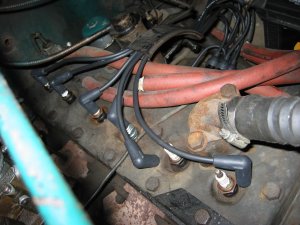April-May, 2005
Earlier this year the car refused to start. My dad and I both have been troubleshooting and it seems that a lot of things are not right. Time for some maintenance.
 First problem: The spark plugs and wires are pretty old and not very good. Dad recommended copper-cored wires. Local sources did not have them so I ordered a complete set of ignition parts from Studebaker Parts Online. I also ordered a carburetor rebuild kit but I am holding off on that. The new cap and wires are to the right. First problem: The spark plugs and wires are pretty old and not very good. Dad recommended copper-cored wires. Local sources did not have them so I ordered a complete set of ignition parts from Studebaker Parts Online. I also ordered a carburetor rebuild kit but I am holding off on that. The new cap and wires are to the right. |
 Here is the business end of the wires. The old plugs are still in since the new ones had to be ordered and had not arrived yet. Note the heater hoses on top of the engine. The heater cores are currently bypassed. Here is the business end of the wires. The old plugs are still in since the new ones had to be ordered and had not arrived yet. Note the heater hoses on top of the engine. The heater cores are currently bypassed. |
 And here are the spark plugs. An old plug is on the left. They were not horrible but had been used and were at least 25 years old… The new ones are a different length. That usually means the plugs are a different “temperature”. I am not sure I cross-referenced this correctly. And here are the spark plugs. An old plug is on the left. They were not horrible but had been used and were at least 25 years old… The new ones are a different length. That usually means the plugs are a different “temperature”. I am not sure I cross-referenced this correctly. |
|
On the left you can see the new pump and the old one. After snapping this picture I transferred all the hoses and fittings from the old pump to the new pump then replaced the pump. After hooking up the pump I used my hand vacuum pump to prime the pump by sucking on the end of the pipe from the fuel pump to the carburetor. |
 One comment my father made was that the car seemed to be cranking slowly. It is a 6 volt system and is very sensitive to any resistance in the wires. So I removed all the wiring between the battery and the starter (including the starter switch). I inspected the wires and cleaned up the terminals. At left is the end if the wire that attaches to the starter. As you can see it has cracks in the insulation but once I cleaned the terminals it had essentially no resistance on my ohm meter so I wrapped the cracks in electrical tape and replaced the wire. One comment my father made was that the car seemed to be cranking slowly. It is a 6 volt system and is very sensitive to any resistance in the wires. So I removed all the wiring between the battery and the starter (including the starter switch). I inspected the wires and cleaned up the terminals. At left is the end if the wire that attaches to the starter. As you can see it has cracks in the insulation but once I cleaned the terminals it had essentially no resistance on my ohm meter so I wrapped the cracks in electrical tape and replaced the wire. |
 The second picture shows the negative battery terminal. Same deal here. The starter circuit is really simple. The battery cable runs from the negative terminal right to the starter switch on the firewall behind the clutch pedal (remember this is a positive ground system). All other power for the car is pulled from this terminal on the starter switch. The other end of the starter switch is connected directly to the starter via a huge wire running under the bell housing of the transmission.After cleaning everything and reconnecting the wires the car does crank noticeably faster. Mission accomplished! Although it does occur to me that I need to also check the ground strap and positive battery cables too. The second picture shows the negative battery terminal. Same deal here. The starter circuit is really simple. The battery cable runs from the negative terminal right to the starter switch on the firewall behind the clutch pedal (remember this is a positive ground system). All other power for the car is pulled from this terminal on the starter switch. The other end of the starter switch is connected directly to the starter via a huge wire running under the bell housing of the transmission.After cleaning everything and reconnecting the wires the car does crank noticeably faster. Mission accomplished! Although it does occur to me that I need to also check the ground strap and positive battery cables too. |


